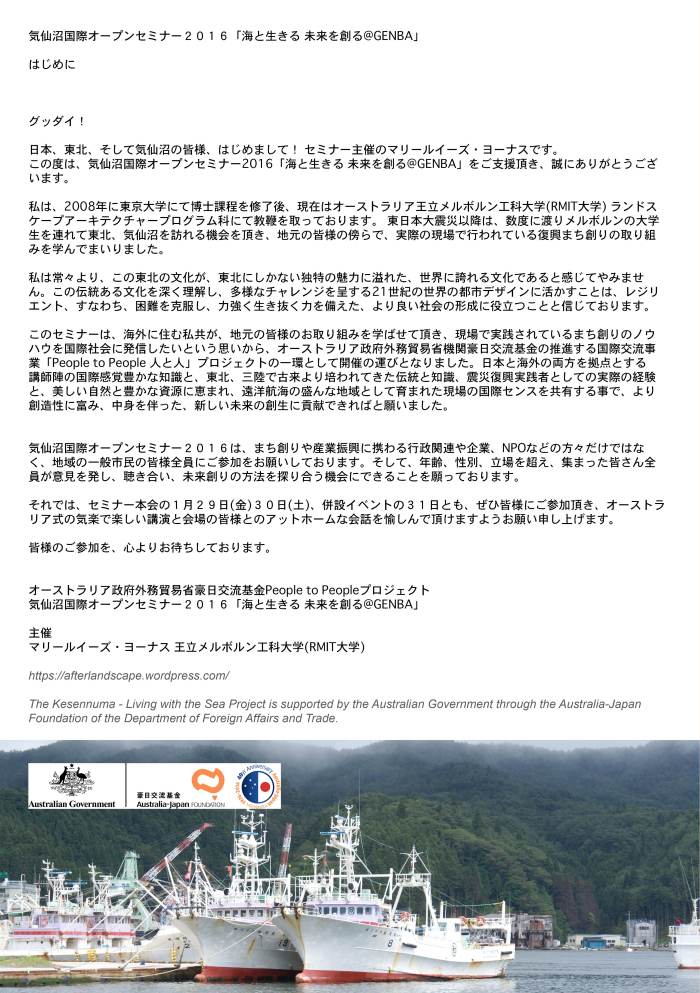
The Japanese message is roughly translated as this:
Good Day!
I am Marieluise Jonas, I work at RMIT University in Landscape Architecture Program and I have graduated form Tokyo University in 2008.
Since 3/11 I have been working with people in Tohoku and I have brought students from Australia to Tohoku and Kesennuma many times. I think that Tohoku has a unique culture and I am very interested to understand how your culture can help us understand to build better and more resilient cities in vulnerable environments.
I would like to learn about your local initiatives and would like share your ideas with a international audience. Therefore I am organizing an Open Seminar in Kesennuma.
The symposium aims to be mutually inspiring and enriching.
The Open Seminar is an invitation to everyone to join: to share, listen and develop ideas – together!
Please join us @GENBA on Friday 29th January and Saturday 30th January for informal presentations of ideas and discussion. Meet us informally on the 31st January.
I look forward to meeting you there!
Marieluise Jonas, RMIT University, Australia
+++++++++++++++++++++++++++++++++++++++++++++++++++++++++++++++++++++
Kesennuma Future Proofing Open Seminar Day 01

Friday 29. January 2016 — Day 01
Session 01 – Rethinking Environment and defining Resilience
Shusuke Hirose, Tohoku Landscape Notes
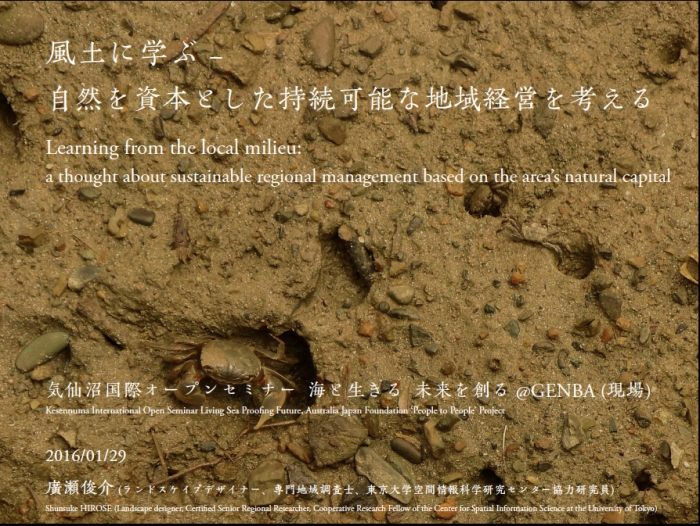
Learning form the local milieu: a thought about sustainable regional management based on the area’s natural capital
In his talk Hirose Sensei discussed the aspects of environmental capital through a lens of site specific mappings of localized ecosystems. Hirose reminded us to regard the specific aspects of regional landscapes such as soil conditions, climate and exposure as keys to forming local habitation cultures.
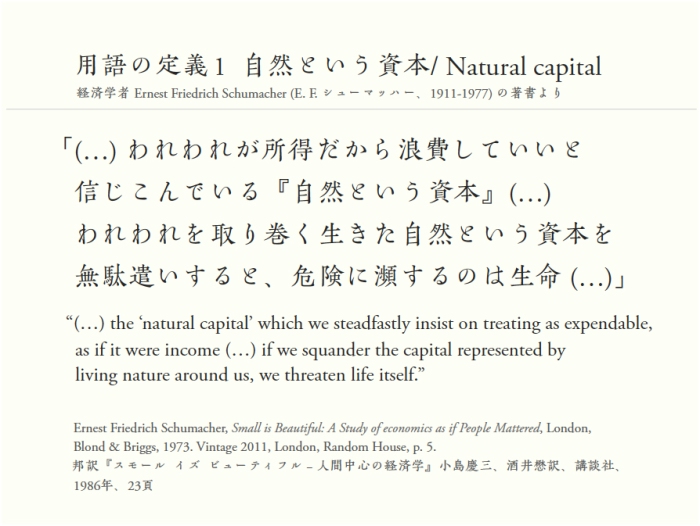
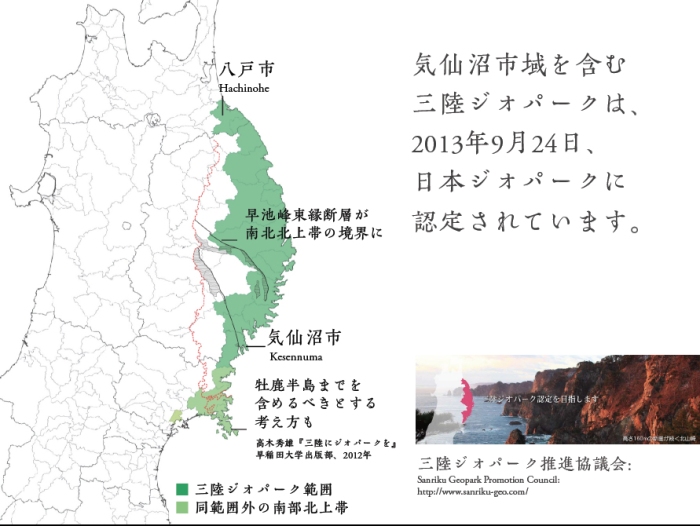
Information on Sanriku Geopark
Akihiro Nakamura – Defining Resilience for local approaches
Nakamura Sensei discussed various concept approaches of resilience definitions and pushed the audience to participate in rethinking their individual ideas for how the term would be considered useful in their context. Specifically a shifting away form Hardware [fortified environments; infrastructural measures] was suggested. Instead an approach to building resilient Software [communities] was encouraged.
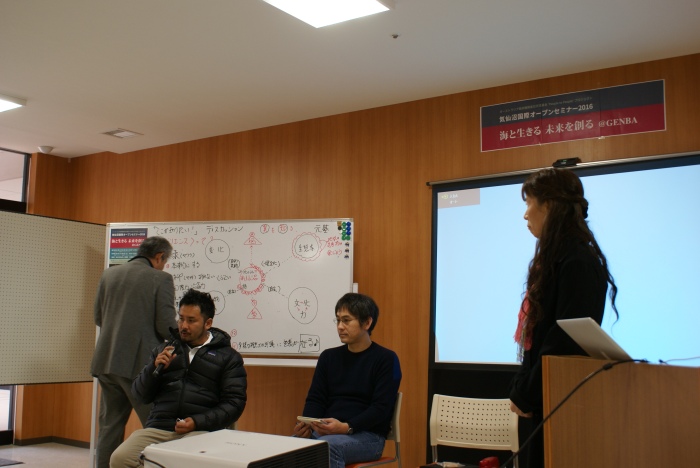
+++++++++++++++++++++++++++++++++++++++++++++++++++++++++++++++++++++
Session 02 – Social Innovation
Hiroko Otsuka – Optimism and the story of women of the rocky shores
Otsuka san discussed a connection of two places: Kesennuma and Hobart through her own life experience of growing up in Kesennuma and moving to Hobart aged 21. Otsuka san reflected on her own experience of loss, grieving and activism. Being the founder of “Think Seawall” and “Sea the sea” as well as “Disaster Risk Reduction Women’s Working Group” and “Think across.inc” she has worked as activist and organized since 3/11 occurred. In her session Hiroko motivated the audience to define and exchange their own terms of “Optimism”. Think Seawall
Barbara Hartley – @Genba: Women’s stories of disaster and recovery
Hartley san brought the discussion to defining Genba “the site of the event” and presented a range of definition ideas:
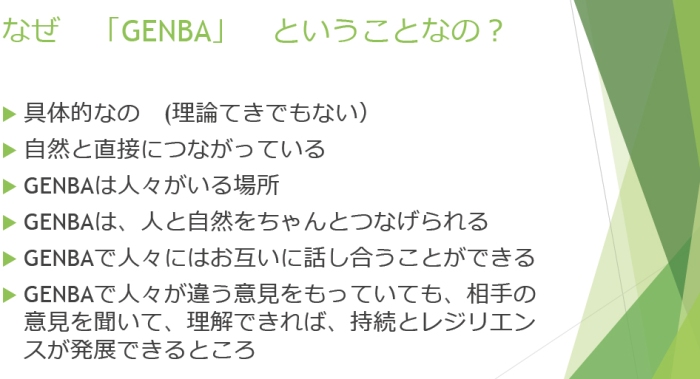
In addition to the discussion of Genba, Barbara reflected on her work in collecting stories of women in context of disaster such as the 2011 Queensland Floods and recent bush fire events in Australia. She made the point, that disasters are universal and we are in need of knowing form women who have first hand experience in order to learn and adapt.
Barbara cited groups such as the “Firefoxes” and “the National Rural Women’s Coalition (NRWC)” as examples of women’s groups who shape distinct futures of equally empowered societies.

The outcome of day 01 was a lively discussion among panelists and participants with the help of Nobuyuki Takahashi to define “Genba”, relationships between site and resilience, social capital and social innovation. In short, what can we learn form Kesennuma?
https://afterlandscape.wordpress.com/2016/02/03/kesennuma-future-proofing-open-seminar-day-01
+++++++++++++++++++++++++++++++++++++++++++++++++++++++++++++++++++++
Kesennuma Future Proofing Open Seminar Day 02
Session 03 – Why we are here @Genba: Design Research
Marieluise Jonas – RMIT University
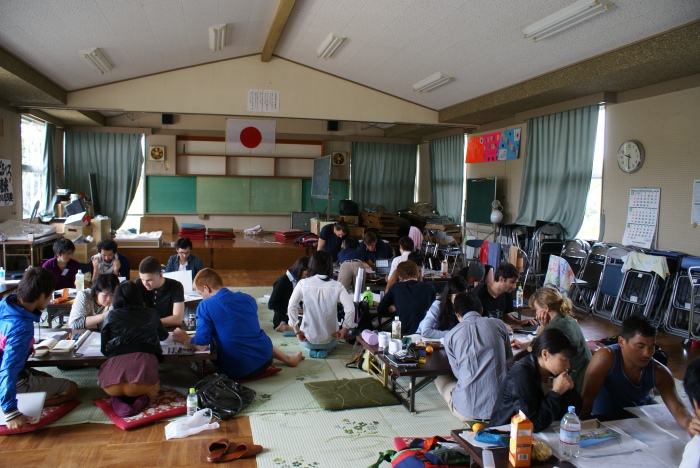
In the short talk, I focused on the value of teaching students in the built environment sector through a site based and exploratory design research framework.
This framework is a shift away from learning based on observation and distanced analysis to an applied learning strategy, which is actively engaging students to work -not only with- but in the environment closely with industry and communities. By investigating landscape architecture research problems through the medium of design students are able to actively contribute to addressing complex issues through their work and initiate change.
My suggestion in conclusion was: Kesennuma can become a center for learning, research and innovation in disaster mitigation for the future through the approach of site specific design research.
Masao Hijikata – Hashikami Project Report
Hijikata Sensei gave an overview of his work in Hashikami, Kesennuma. He emphasized the approach of community based design consultation in machizukuri.
The Koyo High-School is designated as a Tsunami Memorial and Prof. Hijikata discussed his ideas of preservation and memory in the design.
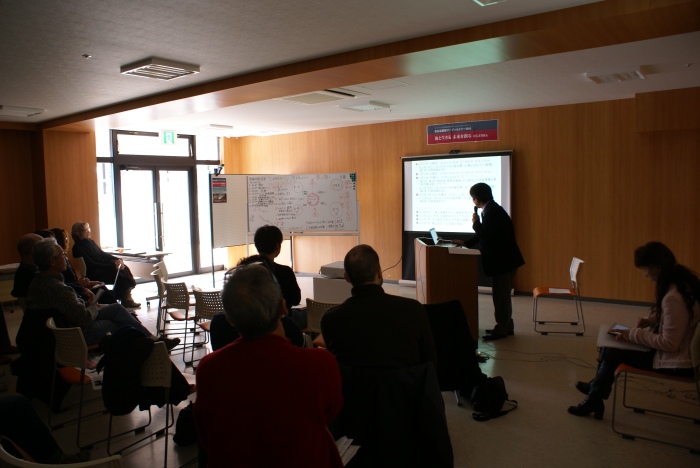
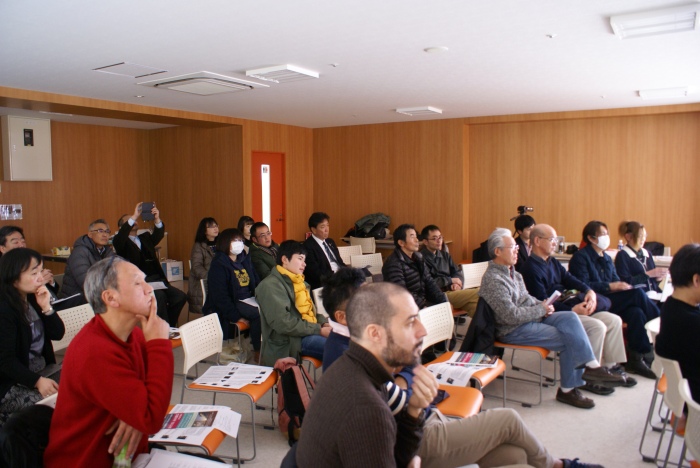
Christian Dimmer – Rettenbach, the happiest village in Germany
In his presentation Christian discussed Rettenbach, a village in the south of Germany, that became an independent energy producer. Christian successfully brought global challenges such as declining rural areas, aging society together in an argument for localized and decentralized governance. Further, Christian highlighted the fact that in Rettenbach a clear aim of independence had been set and that the process had been underway for 2 decades.
The audience was especially impressed by the possibilities and ideas outlined in Christians talk and engaged in a lively discussion.
Akihiro Nakamura – Localized business ideas

In his second talk, Aki shared his idea and a short video of “The Wooden Boat Centre Tasmania” as an approach of combing local heritage and culture with small economies.
https://afterlandscape.wordpress.com/2016/02/05/kesennuma-future-proofing-open-seminar-day-02
+++++++++++++++++++++++++++++++++++++++++++++++++++++++++++++++++++++
Kesennuma Future Proofing Open Seminar: Confirmed Speakers
Professor Masao Hijikata // Hijikata Lab // Waseda University
 Masao Hijikata is a Professor in Social Science for Information Science and Engineering, Industrial Management at Waseda University. Professor Hijikata has been working in supporting the reconstruction of Tohoku and Kesennuma since 2011 in district and town planning.
Masao Hijikata is a Professor in Social Science for Information Science and Engineering, Industrial Management at Waseda University. Professor Hijikata has been working in supporting the reconstruction of Tohoku and Kesennuma since 2011 in district and town planning.
土方正夫
早稻 田大学理工学部でとシステム工学を学び現早稲田大学社会科学部教授。専門は社会情報学。地域計画のための情報システム開発の研究 に従事する。4年前より気仙沼市階上地区まちづくり協議会のアドバイザーと して住民の手による階上地区復興計画づくりの支援に参画している。
講演の要旨
今 や住民の手による”まちづくり”は日本のみならず戦後世界中 で進められているが、現在まちづくりと行政が進める都市計画を繋ぐコミュニ ケーションシステムのデザインが一つの大きな課題となっている。ここでは階上まちづくりの実例を紹介し、今後のまちづくりの課題について参加される皆さん と共に考えるヒントを提供出来ればと考えている。
Hiroko Otsuka: Sea the Future! // Sea the Future
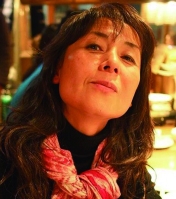 Hiroko Otsuka is the leader of Sea the Future, ThinkAcross, Think Seawall and a key project support manager for the Kesennuma Open Seminar 2016.
Hiroko Otsuka is the leader of Sea the Future, ThinkAcross, Think Seawall and a key project support manager for the Kesennuma Open Seminar 2016.
Hiroko born in Kesennuma as a daughter of a Fisherman, moved to Australia in 1990 and worked as Japanese Lecturer in Tasmania between 1992 and 2011. After the Tohoku Earthquake Hiroko became a social innovator and activist and has founded Sea the Future, ThinkAcross, Think Seawall among many projects and activities to support the disaster recovery efforts in Kesennuma. Hiroko discussed her work at the 2014 Sanriku Fukkou Symposium in Tokyo and was invited to speak about her experience and work at the 2015 UN Disaster Risk Reduction world conference in Sendai.
In her talk Hiroko will reflect on her experience as a daughter of a Kesennuma fisherman living in Australia in Japan and the richness of natural environments surrounding her life. Hiroko will discuss ideas of optimism and how in her own experience this has shaped her work.
大塚博子
海、みらい!代表、国際学術交流推進サポート’ThinkAcross’ (シンク アクロス = 考え渉す) 代表、バイリンガルソーシャルメディアページ「Think Seawall 防潮堤を考える」代表、ソーシャルアドボケイト、日本語教師。
気 仙沼市に漁師の娘として生まれる。東日本大震災遺族。宮城県鼎ケ浦高等学校(現気仙沼高等学校)卒業後(株)ビズカンパニー勤務時最優秀業績賞を受賞し 19歳で初の単身海外旅行(フランス)を経験。(株)リクルート長期準職員などを経てニューヨーク州立大学語学留学。1990年ワーキングホリデービザに て渡豪後、タスマニア州ホバート市在住の間、結婚、離婚、働くシングルマザー、社会人大学生として人生経験を深める。1999年タスマニア州成人修学者 WEEK最優秀賞受賞、2000年成人修学者WEEKロンドン世界大会にオーストラリア代表として出席。2002年タスマニア大学文学部卒(中国語・イン ドネシア語専攻)、2004年チャールズ・スチュート大学教育学ディプロマ取得。1992年よりタスマニア大学日本語非常勤講師(2011年震災をきっか けに退職)、2002年よりホバート市マウントカーメルカレッジにて日本語教員を務める傍ら、2011年以降日本とオーストラリアを往復しながら ThinkSeawall防潮堤を考える、海、みらい!防災女性学習会、ThinkAcross 国際学術交流サポート)等を通じ、子供たちの命と幸せな生活を守る未来創生を目標に幅広く活動する。2014年日独協会国際復興シンポジウム、2015年 国連防災会議併設セミナーVoices of Women from Disaster Area などで講演。タスマニア日豪協会元役員/秘書(2003年-2011年)、現ホバート焼津姉妹都市委員会委員(2002年より)
講演要旨
本 講演では、漁師の娘として現場で生まれ育った経験とオーストラリア・タスマニアと三陸という、共に世界に誇れる豊かな自然環境で培った自身の体験を基に、 「普通の女性」が、如何にして海と生き、新しく活力ある未来創りに挑めるかを、近年、世界のリーダー達が注目するオプティミズム(楽観思考)の紹介と全員 参加の社会形成というテーマから探る。三陸の人々が古来から持つと言われる、情に厚く、あっけらかんで、勇気に満ちた生活観と、伝統や地域の繋がり、中で も、「磯場」を暮らしの源として命を育む生き方の現代社会における価値と意義を再確認し、震災を生き抜き、大漁を寿ぎ、海の神様に畏敬と感謝の念を捧げな がら築く未来の大切さを、現場からの参加者と共に考察する。
Christian Dimmer // Urban Design Lab Tokyo University // Tohoku Planning Forum
 Christian Dimmer born 1973 in Germany, graduated as Spatial and Environmental Designer from the Technical University Kaiserslautern. He earned his PhD from the University of Tokyo on the history of public space in Japan and served as JSPS post-doctoral fellow at University of Tokyo’s Interfaculty Initiative in Information Studies. He is partner of the architecture practice Front office Tokyo and worked with Arata Isozaki & Associates and Mitsubishi Estate. He is founder of the non-profit organization Tohoku Planning Forum, TPF2 and is assistant professor for urban design at the University of Tokyo. He teaches also courses on sustainable urbanism, planning theory, theories of public space, and global urbanism at Waseda University.
Christian Dimmer born 1973 in Germany, graduated as Spatial and Environmental Designer from the Technical University Kaiserslautern. He earned his PhD from the University of Tokyo on the history of public space in Japan and served as JSPS post-doctoral fellow at University of Tokyo’s Interfaculty Initiative in Information Studies. He is partner of the architecture practice Front office Tokyo and worked with Arata Isozaki & Associates and Mitsubishi Estate. He is founder of the non-profit organization Tohoku Planning Forum, TPF2 and is assistant professor for urban design at the University of Tokyo. He teaches also courses on sustainable urbanism, planning theory, theories of public space, and global urbanism at Waseda University.
Christian will discuss the relationship between Economy and an idea of “Gross National Happiness”. He asks the question of relation between lifestyle, resources and slow life, and localized culture and traditions. Through the example of the Solar Village Rettenbach in Germany, Christian will show how villagers can empower themselves to become independent producers of energy and define an own approach to lifestyle and happiness.
クリスティアン・ディマ
東京大学都市デザイン研究室助教
都市計画家、都市研究者
博 士論文「公共空間の再構築―日本の現代大都市の公共空間の歴史的批評とその再評価」で東京大学にて博士号取得後、東京大学大学院情報学環所属の日本学術振 興会特別研究員として「公共空間の政治と論争」と「都市運動」をテーマに研究活動を行う。同時に建築設計事務所であるイソザキ・アオキ アンド アソシエイツや、不動産ディベロッパーの三菱地所などと協働し、また東京に本拠地をおいて建築活動を行う「Frontoffice」の共同立ち上げ人でも ある。そして東日本大震災で被害を受けた地域における、レジリエンスをもち適応可能なコミュニティ復興のための革新的なアイディアを交換するための災害対 応型慈善組織「Architecture For Humanity」東京支部と「東北プランニングフォーラム」の立ち上げ人でもある。現在、持続可能なアーバニズム、公共空間の理論、グローバル・アーバ ニズムとプランニング理論について早稲田大学国際教養学部と上智大学で教鞭をとっている。
講演要旨
近年世界では脱成長、定 常 型社会、国民総幸福量等の概念が注目されている。消費に重点を置いた経済成長が幸せな生活を生むという考え方から、この成長志向こそが資源枯渇、気候変 動、社会的緊張の増大などを齎したのではという考え方だ。本セミナーでは、この文脈を考察しながら、空間、時間、資源の共有化と持続可能で満足度の高いラ イフスタイルを実現すること、その為には、経済・環境・社会の分野を越えたトランジション(変遷)と自律的に思考し行動する市民の存在こそが重要な鍵であ るという命題を掲げる。ドイツ、レッテンバッハ村(太陽の村)の世界一の晴れ男、フィッシャー村長が「自分たちのことは自分たちでやる」哲学で、過疎に喘 ぐ小村で人口のV字回復を成し遂げ、*花咲か爺さんと呼ばれる事になった所以などを紹介しながら、未来のまち創りの普遍的なメッセージを探る。* http://kinoeki.org//uploads/pdf/neba-letten.pdf
Shunsuke Hirose // Tohoku Landscape Notes
 Shusuke Hirose is a Landscape designer (International ASLA), Certified senior regional researcher, Cooperative research fellow of the Center for Spatial Information Science at the University of Tokyo, Member of the Association of Japanese Geographers, Member of the Tohoku Geographical Association and Member of the Japan Association for Landscape Ecology.
Shusuke Hirose is a Landscape designer (International ASLA), Certified senior regional researcher, Cooperative research fellow of the Center for Spatial Information Science at the University of Tokyo, Member of the Association of Japanese Geographers, Member of the Tohoku Geographical Association and Member of the Japan Association for Landscape Ecology.
Shunsuke is a Member of Tohoku revitalization Support Team (TRST)/ Land Use Assessment, Urban and Regional Planning and former associate professor of the Tohoku University of Art and Design (from April of 2004 to March of 2013), and former associate professor of Graduate School of Tohoku University of Art and Design (from April of 2013 to March of 2014). Important works ” Landscape As Capital” (2011)
Shunsuke will discuss the inherent connection between people and land and suggest that landscape, climate shape local traditions. Shunsuke argues that to understand “Nature Capital” in economic terms is key to building resilient communities.
廣瀬俊介
1967年千葉県市川市生まれ。環境デザイナー (ASLA: 米国ランドスケイプアーキテクト協会国際会員)、専門地域調査士 (認定機関: 日本地理学会)。 風土形成事務所主宰、2014年4月より東京大学空間情報科学研究センター協力研究員。日本地理学会会員、東北地理学会会員、日本景観生態学会会員。2 014年3月まで東北芸術工科大学大学院准教授。主著『風景資本論』朗文堂、2011年。 生物と生態系、人間の創造行為、人間が成す社会へのそれぞれの興味が結びついていったことをきっかけに、人間が生きる環境の形成のあり方を根源的かつ総合 的に探究する手段としてデザインを選び、1989年以来、公園や街路などの設計から都市計画マスタープラン作成までを、持続的な土地・資源利用ならびに風 土の継承・進展の一環として行うべく、研究と実践を続けている。 私生活では、ローリングストーンズが生み出すようなアメリカ黒人音楽に影響を受けたロックを愛好し、ギターとハーモニカを演奏する。ロックを自らの哲学、 行動規範にほぼ等しいものと位置づけてもいる。
講演要旨
講演は、地域の自然に人々がはたらきかけながらかたちづくられる風 土に着目して行う。「風土」は、そのように自然と人間の関係の歴史から成り立つため、風土に学ぶことを通して地域における自然と人間の持続する関係の持ち 方をあらためて知ることができる。また、講演の基礎には、「自然を資本」ととらえる経済学理論をおく。
Barbara Hartley // University of Tasmania Head of Discipline, Asian Languages and Studies
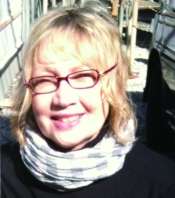
Barbara Hartley, PhD is a Senior Lecturer in the School of Humanities, Faculty of Arts. With a doctorate in Japanese literary studies, she is interested in print and visual representation in twentieth-century Japan and other parts of East Asia. Taking a feminist studies approach, she has written extensively on Japanese women writers and representations of women in Japanese literature. Her more recent work, however, brings this background to the study of representations of the Asian continent – particularly China – in Japanese narrative and print material. This was the topic of her 2015 REGS grant, with a focus on the city of Shanghai.
Barbara will discuss how an individual narrative and personal stories of the experiences in rebuilding can help in building more resilient communities in the aftermath of disaster and loss. Through the example of Australian communities affected by bushfire disasters, Barraba will discuss how women have become empowered to lead their communities.
バーバラ・ハートリー
オー ストラリア・クイーンズランド州出身。クイーンズランド大学人文学部博士課程修了(Ph.D)。論題は『日本の二十世紀の文学における母性像』。現在、タ スマニア大学人文学部人文学科教授、アジア言語研究科長(日本語日本文化専攻)。近現代日本の文学や美術作品に描かれるジェンダー、身体、ナショナリズム を主な研究分野とし、現在は武田泰淳の文学における「大陸像」について執筆中。
講演要旨
講 演は、災害復興プロセスによる個々人のナラティブ(意見や経験談)の価値に注目して行う。 オーストラリアで起きた山火事を事例とし、どのようにコミュニティによる経験談が被害者らの喪失感への自己解放に繋がり、また将来に向けた個々人やコミュ ニティの持続可能なビジョンを構築するのか考察する。この研究では、特に経験談を話す過程による女性の役割に重点を置き、また女性たちのナラティブがどの ように コミュニテリィリーダシップに繋がるかに着目する。
Akihiro Nakamura // Social Science, the University of Tasmania, Australia // The Centre of Environmental Law, Meiji University, Japan
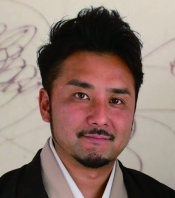 Akihiro Nakamura, PhD, is an environmental policy researcher at the School of Social Sciences at the University of Tasmania. Akihiro has worked at the Institute of Environmental Sustainable Policy in Japan, is an Honorary Adjunct Researcher at the Centre of Environmental Law at the Meiji University in Japan since 2013.
Akihiro Nakamura, PhD, is an environmental policy researcher at the School of Social Sciences at the University of Tasmania. Akihiro has worked at the Institute of Environmental Sustainable Policy in Japan, is an Honorary Adjunct Researcher at the Centre of Environmental Law at the Meiji University in Japan since 2013.
Akihiro’s research interests include: sustainable environmental management; coastal management and environmental policy and law. Akihiro is also a surfer and runs a Japanese restaurant in Hobart.
In talks Akihiro will focus on environmental policy, urban resilience and discuss opportunities for new business models in the region.
中村明寛
オーストラリア、タスマニア大学大学院にて、2007年に環境学修士号(理学)、2011年に公共政治学博士号(PhD)を授与。専門は、主に環境法政策、ガバナンス論、災害法・管理学、レジリエンス。
オー ストラリアを拠点とし、明治大学研究助手/調査支援研究員、財団法人地球環境戦略研究機関リサーチアシスタント、環境エネルギー政策研究所客員研究員を経 て。現在は、 オーストラリアタスマニア大学大学人文学部社会科学研究科、Kate Crowley博士の主催する環境政治・政策研究室のメンバーとして、客員研究員/リサーチアシスタント/臨時講師。 同研究科に所属。同時に、明治大学法科大学院環境法センター客員研究員として現在も活動する。その他の活動として、タスマニア州豪日協会の役員。 現地企業と日本大手商社間の貿易コンサルタント/専属通訳・翻訳 (主に農業・水産業)として現在も携わる 。現タスマニアジャパンセンター代表。
1978 年千葉県生まれ。日本の学生時代サーフィンに没頭し、そこから環境学(特に海岸問題)に興味を持つ。大学卒業を機に、祖国日本や環境学という学問を外から 見て学ぶことに意義を感じ、オーストラリアへ渡る事を決意する。人類とは何か?政策とは何か?民主主義とは一体なんなのか?という素朴な疑問を常に追求 し、様々な視点で環境学の魅力さ、重要さ、複雑さを学ぶ。大学院修士課程はサイエンスに重点をおいていたが、実践的な環境改善には政治や政策の役割が重要 であると気付き博士課程は公共政策に移り、気候変動政策の手段論の開発に力を注ぐ。博士論文のテーマは、「法的拘束力、非法的拘束力の気候変動政策手段と その新しい比較手法」。
現在は、主に気候変動緩和策・適応策、地域的国際枠組みの提案、コミュニティレジリエンスや‘まちづくり’に関する研究プロジェクトをオーストラリア拠点に実施している。
第1日「レジリエンスと環境政策とは?」
人 間社会や地域社会を動かし、ビジョンやマネージメントを考えるうえで、政策とは欠かせない存在である。近年、災害マネージメントを含む 環境政策に関連した分野では、理系、文系問わず、「レジリエンス」という言葉が広範囲に、そして頻繁に使われている。しかしながら、その定義は依然として 明確ではない。 講演では、人類が今後、地球温暖化 や自然災害など様々な影響やリスクと向き合う中で、レジリエンスという言葉がいったい私たちに何を意味するのか?また、環境政策の役割とは? に着目する。
第2日「地域発信型の新しいビジネスモデルの形とは?」
ビジネスモデルとは、その目的や形によって多 種多様であり、善し悪しは単純に計ることができない。また、利益を追求することは重要であるが、ビジネスの意義とのバランスが必要である。 講演では、持続可能な地域発信のビジネスモデルとは何か?に着目して行う。 オーストラリア、タスマニア州にて既に実践されている地域発信のビジネスモデルの例を紹介し、そこから学べるものことがあるのか、オープンディスカッショ ン形式で行う 。
Marieluise Jonas // Tokyo Void // After Landscape
 Dr Marieluise Jonas is currently the Program Manager for the Master of Landscape Architecture Program at RMIT University, Melbourne, Australia. She is a landscape architect and urban researcher and has practiced in Germany, Japan and Australia.
Dr Marieluise Jonas is currently the Program Manager for the Master of Landscape Architecture Program at RMIT University, Melbourne, Australia. She is a landscape architect and urban researcher and has practiced in Germany, Japan and Australia.
Marieluise holds a PhD from Tokyo University where she researched the practice and tradition of informal use of space in dense urban conditions. She is affiliated with the University of Tokyo through urban research and post disaster reconstruction projects in Tohoku. In 2013 the Australia Japan Foundation funded a research symposium that Marieluise led in Kesennuma.
A key focus of Marieluise’s practice is the engagement with materiality and a notion of immediacy. In teaching, her approach focuses on on-site experimentation, site interventions and making where she can draw on a background in landscape construction.
The 2014 book publication Tokyo Void Possibilities in Absence co-authored with Dr Heike Rahmann is a reflection on the ongoing investigation of urban vacant spaces in Tokyo. The research focus on urban vacant spaces has extended from Tokyo to other Asian metropolises, Europe, USA and Australia and has been published in Journals and book chapters.
In her introduction, Marieluise will discuss her ongoing work in Tohoku and how student’s work produced has contributed to a shifting understanding of vulnerable landscapes.
マリールイーズ・ヨーナス
ドイツ、日本、オーストラリアを拠点に活躍するランドスケープアーキテク ト・都市学研究者。王立メルボルン工科大学(RMIT) デザインプログラム過程ランドスケープアーキテクチャー学科プログラムマネージャー。人口密集都市環境におけるインフォーマルな空間の実例とその伝統を究 明する論文で東京大学より博士号取得。都市研究と東日本大震災後の東北の復興街づくり支援プロジェクを通し東京大学客員研究者を務める。2013年豪日交 流基金助成によるリサーチシンポジウムを気仙沼にて主催。研究の焦点は実質性と即時性概念との係合にあり、授業では、現場での実験課題や、現場介入、景観 デザインをその背景に描く為の場所作りに重点を置く。
2014年出版のハイケ・ラーマン博士との共著’ Tokyo Void Possibilities’ は、継続的な大都市東京の空きスペースのリサーチを反映し、その焦点は東京からアジア諸国の大都市、ヨーロッパ、アメリカ、オーストラリアへも拡大し、雑 誌書籍掲載の諸著に反映されている。また、もう一方の研究焦点はランドスケープデザインの研究実践の探求にある。


https://afterlandscape.wordpress.com/2016/01/22/kesennuma-future-proofing-seminar-confirmed-speakers




